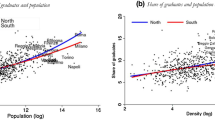Abstract
In the knowledge era, the importance of highly-qualified human capital has been widely recognized as a key factor for local economic development, especially for those areas specialized in science and technology (S&T). Assuming a regional perspective, the capacity to attract this kind of people is both a sign of territorial competitiveness and a way to further reinforce this by boosting the quality of the local labour market in a self-reinforcing process. In line with this perspective, universities play a fundamental role because they can attract students from elsewhere, and then provide local firms with qualified workers. On the other hand, this process is particularly detrimental for territories suffering ‘brain drain’. This paper aims to show this process of selective migration in the case of Italian S&T university students. Specifically, we use a spatial gravity model to show that university students move from Southern towards Northern regions to study in S&T universities, and this mechanism is driven by the dynamism of local labour markets, and not just by the quality of universities. In our view, these results are supportive of the hypothesis that skill-biased migration occurs also very early in the lives of migrants, i.e., at the time they choose university.


Similar content being viewed by others
Notes
As already mentioned in the introduction, there is also the practical advantage of the presence of specific datasets which allow the hypotheses to be tested.
For a comparative analysis across groups, see Dotti et al. (2013).
The distance, in this case, is measured as the arc distance between the centroids of the provinces.
Firms are asked which kind of graduate they plan to hire by distinguishing between 22 categories, which are, however, (originally in the survey) aggregated to the four categories corresponding to those of graduates: S&T, Social Sciences, Humanities, Medicine.
Almost all provinces host one or more campuses; however, many of them only host secondary, ancillary, campuses in which teaching takes place but often the professors do not stay for research, instead preferring to do research in the main campus.
These are empirically determined as those provinces for which the ratio between student in-flows and the resident population is two standard deviations above the national average.
References
Avveduto S (2012) High skilled migration: still a brain drain problem? Italian Rev Econ Demogr Stat (RIEDS—Rivista Italiana Di Economia, Demografia E Statistica) LXVI(2):39–56
Banca d’Italia (2005) Relazione Annuale. Roma: Banca d’Italia
Baryla Er, Dotterweich D (2001) Student migration: do significant factors vary by region? Educ Econ 9(3):269–280
Boschma R, Iammarino S (2007) Related variety and regional growth in Italy (SPRU Working Paper Series No. 162). SPRU—Science and Technology Policy Research, University of Sussex
Ciriaci, D (2005) La fuga del capitale umano qualificato dal Mezzogiorno: un catching up sempre più difficile. Rivista Economica del Mezzogiorno 19(2–3):369–403
Ciriaci D, Muscio A (2010) Does university choice drive graduates’ employability? (MPRA Paper No. 22527). University Library of Munich, Germany
Ciriaci D, Muscio A (2011) University choice, research quality and graduates’ employability: evidence from Italian national survey data (Working Paper No. 48). AlmaLaurea Inter-University Consortium
Dotterweich D, Baryla Er (2005) Non-resident tuition and enrollment in higher education: implications for tuition pricing. Educ Econ 13(4):375–385
Dotti NF (2007) Università conoscenza territorio. Territorio 43:112–120
Dotti NF, Fratesi U, Lenzi C, Percoco M (2013) Local labour markets and the interregional mobility of Italian University students. Spat Econ Anal 8(4):443–468
Dunford M (2002) Italian regional evolutions. Environ Plan 34(4):657–694
Faggian A, McCann P (2006) Human capital flows and regional knowledge assets: a simultaneous equation model. Oxford Economic Papers 58(3):475–500
Faggian A, McCann P (2009) Universities, agglomerations and graduate human capital mobility. Tijdschrift Voor Economische En Sociale Geografie 100(2):210–223
Fratesi U, Riggi MR (2007) Does migration reduce regional disparities? The role of skill-selective flows. Rev Urban Regional Dev Stud 19(1):78–102
Fratesi U, Percoco M (2014) Selective migration, regional growth and convergence: evidence from Italy. Regional Stud. doi:10.1080/00343404.2013.843162
Gagliardi L, Percoco M (2011) Regional disparities in Italy over the long run: the role of human capital and trade policy. Region Dev 33:81–105
Hsing Y, Mixon Fr (1996) A regional study of net migration rates of college students. Rev Regional Stud 26(2):197–209
Jaffe, AB (1989) Real effects of academic research. American Economic Review 79(5):957–970
Kanbur R, Rapoport H (2005) Migration selectivity and the evolution of spatial inequality. J Econ Geogr 5(1):43–57
Iammarino S, Marinelli E (2012) Education-Job (Mis)Matching And Interregional Migration: Italian University Graduates’ Transition To Work (Working Paper No. 8). Birkbeck Centre for Innovation Management Research.
Leydesdorff L, Etkowitz H (1998) The triple-helix as a model for innovation studies. Sci Pub Policy 3:195–203
Sá C, Florax R, Rietveld P (2004) Determinants of the regional demand for higher education in The Netherlands: a gravity model approach. Regional Stud 38(4):375–392
Sá C, Florax R, Rietveld P (2006) Does Accessibility to Higher Education Matter? Choice Behaviour of High School Graduates in the Netherlands. Spatial Economic Analysis 1(2):155–174
Svimez (2009) Rapporto sull’economia del Mezzogiorno 2008. Bologna: il Mulino
Svimez (2013) Rapporto sull’economia del Mezzogiorno 2013. Bologna: il Mulino
Vidal J-P (1998) The effect of emigration on human capital formation. J Popul Econ 11(4):589–600
Viesti, G (2005) Nuove migrazioni. Il ‘trasferimento’ di forza lavoro giovane e qualificata dal Sud al Nord. Il Mulino 4:678–688
Author information
Authors and Affiliations
Corresponding author
Appendix
Appendix
Rights and permissions
About this article
Cite this article
Dotti, N., Fratesi, U., Lenzi, C. et al. Local labour market conditions and the spatial mobility of science and technology university students: evidence from Italy. Rev Reg Res 34, 119–137 (2014). https://doi.org/10.1007/s10037-014-0088-y
Received:
Accepted:
Published:
Issue Date:
DOI: https://doi.org/10.1007/s10037-014-0088-y




